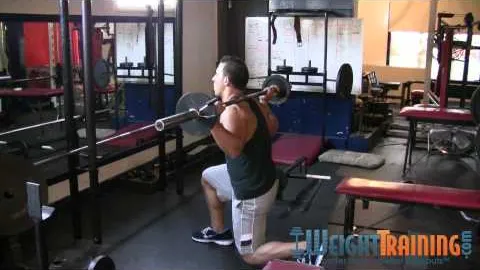
If you are looking to effectively target your lower body muscles, the barbell rear lunge is an exercise you should definitely consider adding to your fitness routine. This compound movement primarily engages your quadriceps, hamstrings, glutes, and calves, helping you build strength, improve balance, and enhance overall lower body coordination.
In this article, we will delve into the proper form, benefits, variations, and precautions associated with the barbell rear lunge, providing you with a comprehensive guide to mastering this exercise.
To perform the barbell rear lunge correctly, follow the steps outlined below:
Maintaining control throughout the exercise is crucial. Focus on keeping your front knee in line with your ankle, avoiding excessive forward lean or knee collapse.
Leg Strength and Development: Barbell rear lunges are a fantastic exercise for strengthening and developing the muscles in your lower body. By consistently incorporating this exercise into your routine, you can expect noticeable gains in your quadriceps, hamstrings, glutes, and calves.
Improved Balance and Coordination: Barbell rear lunges require a certain level of balance and coordination, as they engage multiple muscle groups simultaneously. This exercise helps you develop better overall balance and coordination, minimizing the risk of falls and injuries, both in fitness and everyday activities.
Increased Caloric Expenditure: Being a compound movement, barbell rear lunges engage several large muscle groups, resulting in a higher caloric expenditure than single-joint exercises. This can be beneficial if you are looking to burn calories and support weight loss efforts.
Enhanced Functional Movement: Strong lower body muscles are essential for performing day-to-day activities with ease. By regularly incorporating barbell rear lunges into your workout routine, you can develop better functional movement patterns, making activities like walking, climbing stairs, and lifting objects easier and more efficient.
Dumbbell Rear Lunges: If you don't have access to a barbell, you can perform rear lunges with dumbbells instead. Hold a dumbbell in each hand, allowing your arms to hang naturally by your sides, and follow the same form as the barbell rear lunge.
Front Rack Barbell Rear Lunges: This variation involves holding the barbell in the front rack position, with your elbows lifted and forearms parallel to the ground. Front rack barbell rear lunges engage your core and upper body muscles to a greater extent, making it more challenging than the traditional variation.
Walking Barbell Rear Lunges: As the name suggests, this variation involves performing rear lunges while walking forward. This variation adds an element of dynamic movement and further challenges your balance and stability.
To ensure safe and effective practice of barbell rear lunges, keep the following precautions in mind:
Start with Light Weights: Beginners should start with lighter weights or no weight at all to focus on mastering the movement pattern and maintaining proper form. Gradually increase the weights as you become more comfortable and confident.
Maintain Proper Alignment: Keep your front knee in line with your ankle throughout the exercise to prevent stress on the knee joint. Avoid letting your knee extend beyond your toes.
Control the Descent: When stepping back into the lunge position, control your body's descent to avoid any sudden jerking or loss of balance. This will minimize the risk of injury and allow you to maintain control throughout the movement.
Listen to Your Body: If you experience any sharp pain or discomfort during the exercise, stop immediately and consult a healthcare professional. It's important to prioritize your safety and not push through any pain.
The barbell rear lunge is an effective compound exercise that targets multiple muscle groups in the lower body, aiding in strength development, balance improvement, and functional movement enhancement. By following the proper form and incorporating variations and progressions, you can maximize the benefits of this exercise. Remember to practice caution, start with lighter weights, and listen to your body to ensure safe and effective practice.
Add barbell rear lunges to your fitness routine and reap the rewards of a stronger, more toned lower body.
If you're looking for a gym, fitness club or yoga studio, you've come to the right place.
You can find information about gyms in your area. Browse catalog of gyms and find gyms with classes which are you looking for.
On gym page you can find simple information like address, phone or website. You can find list of available classes. You can check availability of personal training or small group classes. On place page you can also see information about open hours.
You can find gyms near you with amenities, courts, studios and equipments.
Use our map to find gym at your city or district.
In Gym Navigator you can find list of exercises with movies for many body parts.
You can browse exercises catalog and find exercises the best of you.
You can also find exercises grouped into workout plans, which you can use to improve you body. Each routine show you exercises one by one and give you possibility to count you progress and count down rest time.